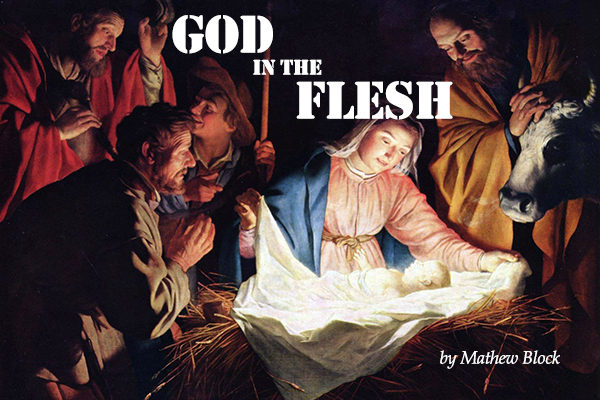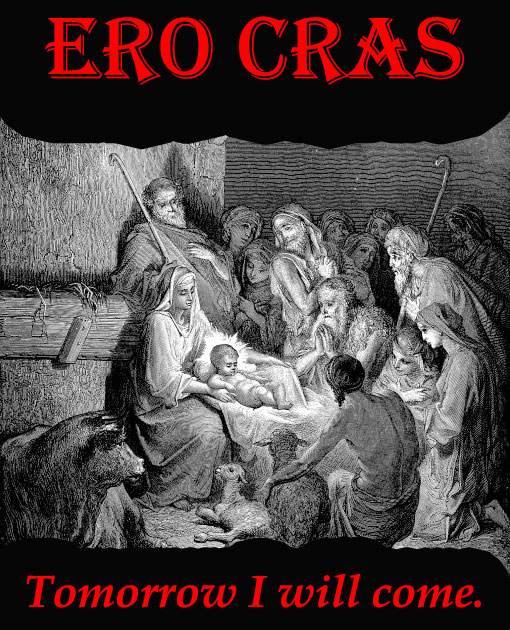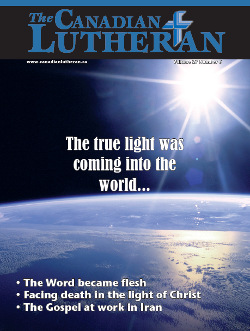Entries tagged with “Christmas”.
Did you find what you wanted?
Wed 24 Dec 2014

My Christmas article for this year is up at The Canadian Lutheran.
“When it comes to Christmas, the picture of the baby Jesus asleep in a manger is etched in our cultural consciousness. We imagine the little Lord Jesus laying down His sweet head in the hay, while stars twinkle away in the sky. How easy it is to forget that this little child is also, in a way beyond our understanding, the God who made the universe. He is the Word who spoke creation into existence (Genesis 1:3 ff; John 1:1-3). And He is the One who continues to sustain creation—the One who holds all things together and gives them being (Colossians 1:17; Acts 17:28).”
But, as I note, that good creation fell. So I ask the question:
“What sort of Saviour could heal and utterly ruined creation? What Saviour could restore the relationship between humanity and God? It could be no mere man for any human born would himself inherit the sinful nature of our first parents Adam and Eve. And yet it must be a man if justice were to be done; humanity had sinned and it was humanity that must pay the price for that sin.”
Thus begins my meditation on the mystery of the Incarnation—an event that brings forgiveness for sinners and restoration to a broken creation. Consequently, we celebrate not only Jesus’ birth at Christmas but our rebirth as well.
“As we celebrate the birth of Mary’s son Jesus we therefore also celebrate our adoption as children of God. For it was the one that made possible the other. ‘To all who received Him, He gave the right to become children of God,’ St. John tells us (John 1:12). All who are in Christ are made new. ‘Therefore if anyone is in Christ, he is a new creation,’ St. Paul explains. ‘The old has passed away; behold, the new has come’ (2 Corinthians 5:17).”
Read the whole thing in “God in the Flesh: The Meaning of Christmas.”
———————
Tue 24 Dec 2013
Posted by Mathew Block under Main
No Comments

In the lead-up to Christmas, we use the O Antiphons as part of our prayer life. In turn we reflect on Sapientia (Wisdom), Adonai (Lord), Radix Jesse (Root of Jesse), Clavis David (Key of David), Oriens (Morning Star), Rex Gentium (King of the nations), and finally Emmanuel (God with us). The first letters of these words in Latin, when read backwards, form an acrostic: ERO CRAS. Put loosely, this is “Tomorrow I will come.”
Let these words be for us a reminder not only that tomorrow is Christmas, but further that we wait on a Lord who will come again—a reminder that “this Jesus, who was taken up from you into heaven, will come in the same way as you saw him go into heaven” (Acts 1:13).
Merry Christmas and God bless.
——————–
Wed 18 Dec 2013

In my column for the November/December issue of The Canadian Lutheran, I reflect at length on the meeting between Gabriel and Mary at the Annunciation, before pondering the Child she would bear. May it prove useful to your own thoughts this Christmas as we rejoice in the Incarnation.
A brief selection:
You can’t help but notice the contrast between the two speakers in this story: an angel of might and a humble young woman. I like the way the old Basque hymn imagines the meeting. It speaks of Gabriel coming down from heaven “his wings as drifted snow, his eyes as flame.” It’s a fearsome image, and contrasts beautifully with “gentle Mary,” who “meekly bowed her head.” It is a meeting of opposites. Might meets humility. Heaven meets earth.
What a striking picture of what would soon take place in Mary’s womb! Here One mightier than Gabriel, mightier than all the angels of heaven together is entering into the story. God is sending His own Son into the world. Christ is coming! But how He comes defies all expectations. He comes not in His power or His glory. No, He meekly bows His head. He humbles Himself, taking on the very form of a servant. Here is One humbler than Mary, taking on a servitude greater than even hers.
The article is called “Might meets humility.” Find the rest over at The Canadian Lutheran.
———————
Sat 22 Dec 2012
Posted by Mathew Block under Articles, Main
No Comments
Today is December 22, and if you’re reading this, the world hasn’t ended. So it looks like the Mayan doomsday believers were wrong—just like all the other end-of-the-world predictions thus far. In my column for the November/December issue of The Canadian Lutheran, I take on the connection between doomsday predictions and the season of Advent (which we’re still in for a few more days). A segment follows below:
 But Christians are not the only ones in a season of “waiting” this December. A small number of conspiracy theorists have been predicting December 21st as the end of the world. The idea arises out of some Mayan records which cite that date as the end of an era—the ending of one cycle of creation and the beginning of the next. While Mayan scholars dismiss doomsday interpretations of these records, believers think the Mayans knew something we don’t— that some great catastrophe is coming and that humankind’s time is drawing to an end. Consequently, this has been a year of great darkness for doomsday believers. They have been living under the shadow of death, a shadow growing ever blacker and grimmer as December 21st approaches.
But Christians are not the only ones in a season of “waiting” this December. A small number of conspiracy theorists have been predicting December 21st as the end of the world. The idea arises out of some Mayan records which cite that date as the end of an era—the ending of one cycle of creation and the beginning of the next. While Mayan scholars dismiss doomsday interpretations of these records, believers think the Mayans knew something we don’t— that some great catastrophe is coming and that humankind’s time is drawing to an end. Consequently, this has been a year of great darkness for doomsday believers. They have been living under the shadow of death, a shadow growing ever blacker and grimmer as December 21st approaches.
How different from the Christian’s hope! We too dwell under the dark shadow of death, but it is a shadow we know is defeated. We await reunion with our Lord Jesus; doomsday theorists see only the approach of death. At the first Christmas, God Himself entered into our world. In Him was Light, a Light that was the Light of all mankind; and that Light broke into the darkness (John 1:4-5). Yes, on the people dwelling in darkness a great Light dawned—and it forced the shadow of death to retreat (Matthew 4:16).
Check out the full article entitled “Joy comes with the morning” over at CanadianLutheran.ca.
——————–
Wed 22 Dec 2010
Posted by Mathew Block under Main
[2] Comments
‘Twas the night before – X-mas? Winter Festival? December Holidays? Festivus? As Canadian society moves in an increasingly secular direction, public disagreement over what to call the season becomes more common. But even when we retain the historic title Christmas, the average person’s thoughts run along the lines of Santa Claus, family dinners, taking time off work, and gift-giving (or getting). The birth of Jesus, if remembered at all, is at best an afterthought. While perhaps the third most important day in the Christian calendar (after Good Friday and Easter), it appears Christmas has lost much of its religious significance for the world around us.
So begin my thoughts in a recent article for The Canadian Lutheran. Entitled “The battle for Christmas,” the article highlights the tensions between Christian and secular understandings of the holiday/holy-day, presenting a historical framework in which to view a very contemporary concern. Check it out in pdf form here or in standard web-format here. (The pdf has an additional subarticle entitled “Keeping Christ in Xmas”, which discusses the origin of the “Xmas” abbreviation which – despite common perception – is actually Christian in nature).



 But Christians are not the only ones in a season of “waiting” this December. A small number of conspiracy theorists have been predicting December 21st as the end of the world. The idea arises out of some Mayan records which cite that date as the end of an era—the ending of one cycle of creation and the beginning of the next. While Mayan scholars dismiss doomsday interpretations of these records, believers think the Mayans knew something we don’t— that some great catastrophe is coming and that humankind’s time is drawing to an end. Consequently, this has been a year of great darkness for doomsday believers. They have been living under the shadow of death, a shadow growing ever blacker and grimmer as December 21st approaches.
But Christians are not the only ones in a season of “waiting” this December. A small number of conspiracy theorists have been predicting December 21st as the end of the world. The idea arises out of some Mayan records which cite that date as the end of an era—the ending of one cycle of creation and the beginning of the next. While Mayan scholars dismiss doomsday interpretations of these records, believers think the Mayans knew something we don’t— that some great catastrophe is coming and that humankind’s time is drawing to an end. Consequently, this has been a year of great darkness for doomsday believers. They have been living under the shadow of death, a shadow growing ever blacker and grimmer as December 21st approaches.

